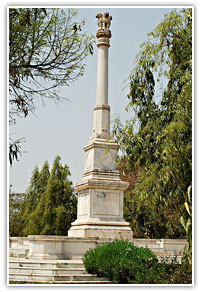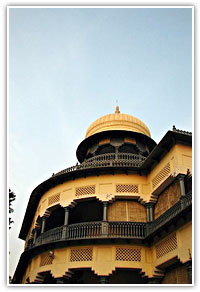|
|
Allahabad Attractions
.............................................................................................................................................................................. |
| Tourist
Attractions in Allahabad |
|
There are various temples and some monuments
belonging to the Muslim period in Allahabad like
Akbar's Fort and Khusrau Bagh. There are also some
buildings which belongs to the British period like
the Alfred Park, Muir College or Allahabad
University, St. Joseph’s Roman Catholic Cathedral,
the Holy Trinity Church, High Court and Minto
Park. Sangam is the another famous attraction in
Allahabad.
Akbar's Fort
The Akbar's fort was built by Akbar in 1584 which
stands majestically at the confluence on the
Yamuna river. It was the largest of his forts and
has three massive gateways and 7 meters high brick
walls. This fort is most impressive when you view
it from the river. Most of the fort is not
accessible to tourists and has an Ashoka Pillar
and the Zenana Palace. The Ashoka Pillar was
re-erected in the Akbar’s Fort on the order of
|
 |
|
|
Akbar
and belongs to 232 BC. It was found lying on the ground
of the fort in 1837 and was set up at the present site.
The Ashoka’s inscriptions are inscribed on its polished
10.6 meters high sandstone shaft. Some inscriptions were
later added by Emperor Samudragupta (A.D. 326-375). This
is the only historical record of the great monarch’s
life. Later, Mughal Emperor Jahangir added his own
inscription on the pillar. A small door in the east wall
of the fort, near the river, leads to the undying banyan
tree which is believed to have existed for thousands of
years.
Khusrau Bagh
The Khusrau Bagh contains the tomb of Prince Khusro, who
was was murdered in 1615 by his own brother as he
rebelled against his own father Jahangir. After staging
an unsuccessful rebellion gainst his father Jahangir in
1607, Khusro spent the next year in chains. Two of his
closest associates were less fortunate. They were sewn
into the skins of a freshly slaughtered ox and ass,
mounted the wrong way round on donkeys and paraded
through the streets of Lahore. The hot sun dried the
skins and one died from suffocation. Khusro was also
forced to ride an elephant down a street lined with the
heads of his supporters. When freed, Khusro underterred
encouraged a plot to assassinate his father but was
discovered. Khusrau was blinded, though he did regain
partial sight and spent the rest of his life as a
captive. Later, he was murdered by his own brother in
1615. The garden is a typical Mughal garden enclosure,
entered through a 18 m high archway and houses the
large, handsome tomb of Khusro. The burial chamber is
undergrouond and the decoration is plasterwork painted
with birds, flowers and Persian inscription. The tombs
of his Rajput mother and sisters are located near by.
Sangam
Sangam is situated at the confluence of the Ganga,
Yamuna and the mythical underground Saraswati river. The
sangam is a narrow spit of land where the rivers gently
mingle and is quite shallow and muddy. At any time of
day or year you will find here people bathing. Every
year, thousands of people gather here for the pilgrimage
and to have the sacred bath in its waters. But, during
the Kumbh Mela, about millions of people gather here to
have the sacred bath at the Sangam. |
|
|
|
Anand Bhawan
Anand Bhawan is the place where the Nehru family
lived and is now converted into a national
monument. This home was given to the state by
Indira Gandhi in 1970. This house contains many
items belonging to the Motilal Nehru, the father
of Jawaharlal Nehru, Jawaharlal Nehru, Indira
Gandhi, Sanjay Gandhi and Rajiv Gandhi.
Buildings from the British Period
Canning Town, opposite the Junction Railway
Station, was laid out on a grid in the 1860.
Within it are the Old High Court and Public
Offices, classical style buildings built in 1870
and the 13th century Gothic style All Saint's
Cathedral started in 1877. At the eastern end of
the Civil Lines is Alfred Park, founded to
commemorate the visit of the Duke of Edinburgh in
1870. North of the park is Muir College, built in
1874-1886 and regarded |
 |
|
|
as the
fine example of Indo-Saracenic architecture. It was
later established as the University of Allahabad. West
of the College is the poorly designed Mayo Memorial
College and west of the park is St. Joseph's Roman
Catholic Cathedral and accompanying schools, all in the
Italian style. The Holy Trinity Church contains
memorials from the Gwalior Campaign and the Mutiny. The
New High Court is Edwardian Baroque. West of the fort is
Minto Park where the Royal Proclamation of the
Assumption of Rule by the Crown (the Magna Carta of
India' according to Curzon) was made in 1858.
Excursion
from Allahabad
Kausambi
Kausambi is situated on NH2, about 45 kms. from
Allahabad. The enormous ruins of Kausambi are spread
through several villages. Kosam-Inam and Kosam-khiraj
are the villages that carries names that still suggest
their links with the ruins of the city of Kausam.
According to the epics, Kausam was founded by a
descendant of the Pandavas who left hastinapur when it
was destroyed by the Udayana. It is also one of the
earliest Historical cities of the region. According to
Hiuen Tsang, the Buddha preached here and in
commemoration of the event, there are two monasteries.
Some excavations were also made here. Many coins and
terracottas discovered here are now displayed in the
Allahabad City museum and Kausambi Museum at the
Allahabad University.
More....
Bhita
Bhita, about 2 km south of Yamuna and 22 km south west
of Allahabad, was the site of a trading community well
before 350 BC., the start of the Mauryan period. A
series of mounds were excavated by Marshall in 1910-11.
Brick structures belonging to five periods were
identified but below these lies a series of occupational
deposits which include Northern Brick Polished Ware,
proving its very early historical origins. |
|